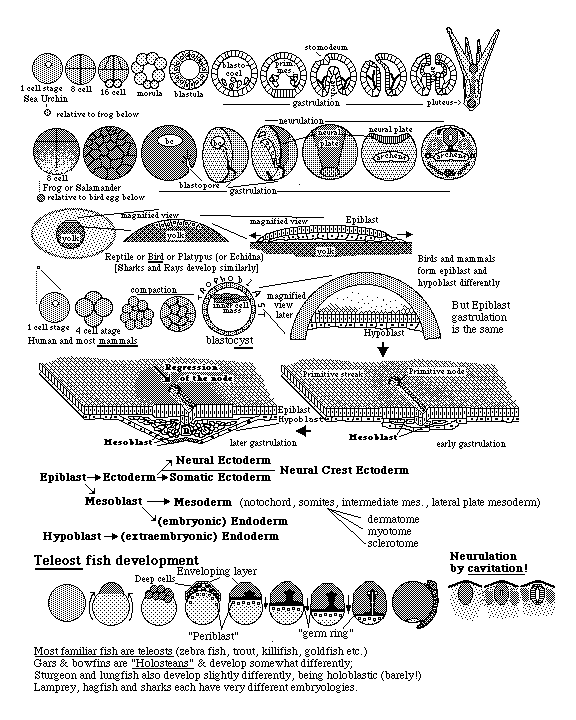http://biology.unc.edu/people/faculty/harris
Labs will start January 18th & 19th
First lecture in Vertebrate Embryology Jan 9, 2012 Albert K Harris
Egg cell= oocyte + :Sperm=spermatozoan → → Trillions of differentiated cells → → Organs & tissues
Small, simple, homogeneous → → → → Large, complex, geometrically complicated
DNA base sequences → → →Anatomical shapes, geometrical arrangements of cells
Many kinds of symmetry → → → → Controlled reduction (symmetry breaking)
* Reflection symmetry, *rotational symmetry, *displacement symmetry, *dilation symmetry
And combinations of symmetries, such as snail shells have combined rotational and dilation.
Segmented organs often combine displacement with dilation symmetry
"radial symmetry, axial symmetry, spherical symmetry" are different degrees of reflection symmetry
For example, 2,3,4,5 etc. planes of reflection symmetry people call radial symmetry;
but we would be better off to call those situations "multiple planes of reflection symmetry"
Physicists, crystallographers etc. have analyzed symmetry more carefully than biologists have.
Very useful for explaining geometrical shapes in terms of mechanisms that cause shapes.
We will come back to these issues in much more depth later in the course.
"Developmental Biology" is embryology from a causal point of view, plus
including phenomena like metamorphosis and aging produced by the same causes.
Whenever a scientific field is progressing rapidly,
there will be major disagreements between researchers and other experts.
For example, I believe that Lewis Wolpert is very, VERY wrong about his "French Flag" analogy for explaining how embryos form and repair geometric patterns. (how genes cause anatomical structures).
In fact, I strongly disagree with many of his ideas, and he dislikes mine so much he doesn't mention me even once this textbook. (I have known Cheryll Tickle and him since 1970 + 71) and had many, many hours of friendly, constructive, discussion with both of them. The real truths probably are half way between their ideas and mine.
You students in the class may become discovers of the real truth.
I apologize to you that the textbook is so expensive. The previous two years, I experimented with much cheaper (+more accurate!) textbooks. But they only covered half the material, were less complete, and often supported my research.
In some ways, that agreement was a good reason to use them, but it means students only get one side of those arguments.
Imagine a right wing teacher using a left wing textbook! Or the reverse?
Before exams, I will always post lists of possible questions.
The textbook also contains hundreds of review and thought questions.
Although emphasis will be a little different this year, I recommend that you take a look at the lists of exam questions from previous years of this course.
My web pages for those years are posted on the "courses" section of my web pages.
No pass-words are needed, since all the photographs, diagrams and drawings are by me, personally. We don't use "blackboard", since my wife knows how to do real HTML.
Never, never, NEVER will higher grades be given for exam answers that support my ideas against Wolpert's or anybody else's ideas, interpretations, theories or conclusions.
In college, I had a couple of professors who did that sort of thing & I have been mad ever since.
When there are two sides to any question, you should learn them BOTH.
I will begin the course by describing and comparing embryos of mammals & sea urchins.
(honorary vertebrates)
and then embryos of amphibians, teleost fish, birds & reptiles.
(Diagrams of all these are combined in one big nifty diagram that I drew
so you could memorize it.)
[Maybe I shouldn't have given up on becoming an artist?]
Please ask lots of questions.
We have plenty of time.
There is no such thing as a dumb question.
The other students will be secretly grateful to you for asking.
